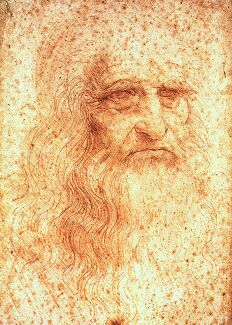Florentine artist
* April 15, 1452 + May 2, 1519
Start• 2 • 3 • 4 • 5 • 6 • 7 • 8 • 9 • 10 • 11 • 12 • 13 • 14 • 15 • 16 • Frm• Home •

Possessing a sprawling intellect that touched astoundingly diverse areas of knowledge, but suffering from a tendency to assume too many projects in various fields, and failing to complete most.
|
The subtlety of expression and glow of faces depicted by Leonardo is attributed in part to his practice of painting by the soft light of dusk with a linen sheet drawn overhead to further diffuse the illumination. The Last Supper, which began to deteriorate in Leonardo's lifetime, suffered further damage when 17th-century monks cut a door through the lower portion, and was nearly destroyed by Allied bombing in World War II. Leonardo established modern techniques of scientific illustration with highly accurate renderings such as Embryo in the Womb. Knowledge of Leonardo's Battle of Anghiari, which was destroyed in the 17th century, is based on later artists' rendering of the work, most notably a drawing by Flemish painter Peter Paul Rubens. Leonardo performed autopsies on corpses to improve his knowledge of physiology, and ridiculed lesser artists' depictions of human flesh, saying they looked like "sacks of nuts." Leonardo da Vinci was, in 1508, the first to suggest the use of contact lenses to correct defective vision. In Germany, nearly four centuries later, the first contact lens manufactured was a glass shell that covered the entire surface of the eye. Modern contact lenses appeared in the 1940s. Today, many Americans prefer them over eyeglasses for reasons of convenience or cosmetics, although spectacles offer far more protection for the eye. |
  |